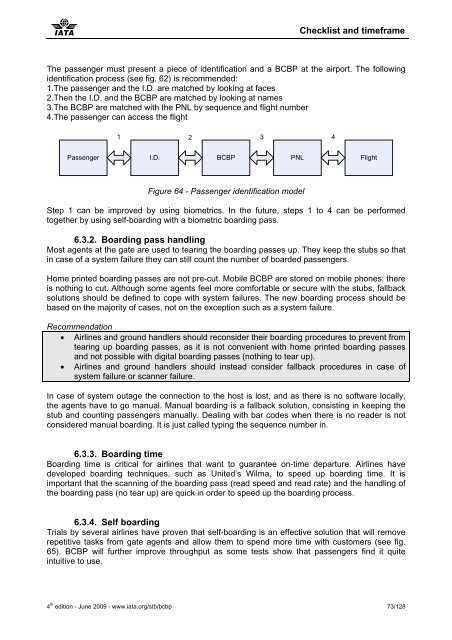Bar-Coded Boarding Passes (BCBP) Implementation guide - IATA
Bar-Coded Boarding Passes (BCBP) Implementation guide - IATA
Bar-Coded Boarding Passes (BCBP) Implementation guide - IATA
Create successful ePaper yourself
Turn your PDF publications into a flip-book with our unique Google optimized e-Paper software.
Checklist and timeframe<br />
The passenger must present a piece of identification and a <strong>BCBP</strong> at the airport. The following<br />
identification process (see fig. 62) is recommended:<br />
1.The passenger and the I.D. are matched by looking at faces<br />
2.Then the I.D. and the <strong>BCBP</strong> are matched by looking at names<br />
3.The <strong>BCBP</strong> are matched with the PNL by sequence and flight number<br />
4.The passenger can access the flight<br />
1 2 3 4<br />
Passenger I.D. <strong>BCBP</strong> PNL Flight<br />
Figure 64 - Passenger identification model<br />
Step 1 can be improved by using biometrics. In the future, steps 1 to 4 can be performed<br />
together by using self-boarding with a biometric boarding pass.<br />
6.3.2. <strong>Boarding</strong> pass handling<br />
Most agents at the gate are used to tearing the boarding passes up. They keep the stubs so that<br />
in case of a system failure they can still count the number of boarded passengers.<br />
Home printed boarding passes are not pre-cut. Mobile <strong>BCBP</strong> are stored on mobile phones: there<br />
is nothing to cut. Although some agents feel more comfortable or secure with the stubs, fallback<br />
solutions should be defined to cope with system failures. The new boarding process should be<br />
based on the majority of cases, not on the exception such as a system failure.<br />
Recommendation<br />
• Airlines and ground handlers should reconsider their boarding procedures to prevent from<br />
tearing up boarding passes, as it is not convenient with home printed boarding passes<br />
and not possible with digital boarding passes (nothing to tear up).<br />
• Airlines and ground handlers should instead consider fallback procedures in case of<br />
system failure or scanner failure.<br />
In case of system outage the connection to the host is lost, and as there is no software locally,<br />
the agents have to go manual. Manual boarding is a fallback solution, consisting in keeping the<br />
stub and counting passengers manually. Dealing with bar codes when there is no reader is not<br />
considered manual boarding. It is just called typing the sequence number in.<br />
6.3.3. <strong>Boarding</strong> time<br />
<strong>Boarding</strong> time is critical for airlines that want to guarantee on-time departure. Airlines have<br />
developed boarding techniques, such as United’s Wilma, to speed up boarding time. It is<br />
important that the scanning of the boarding pass (read speed and read rate) and the handling of<br />
the boarding pass (no tear up) are quick in order to speed up the boarding process.<br />
6.3.4. Self boarding<br />
Trials by several airlines have proven that self-boarding is an effective solution that will remove<br />
repetitive tasks from gate agents and allow them to spend more time with customers (see fig.<br />
65). <strong>BCBP</strong> will further improve throughput as some tests show that passengers find it quite<br />
intuitive to use.<br />
4 th edition - June 2009 - www.iata.org/stb/bcbp 73/128
















